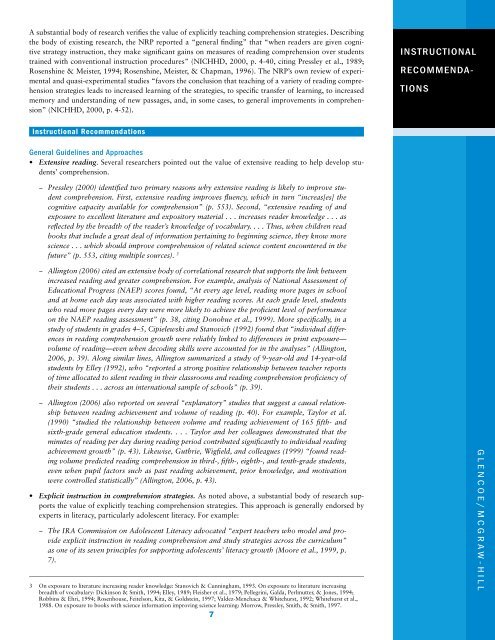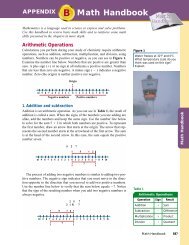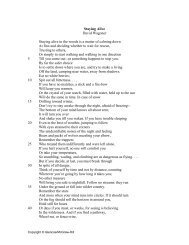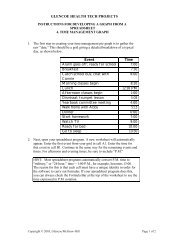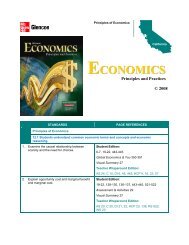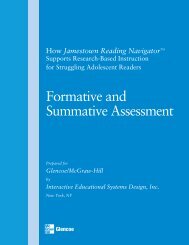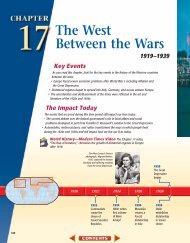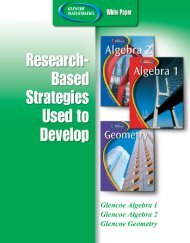Comprehension - Research
Comprehension - Research
Comprehension - Research
Create successful ePaper yourself
Turn your PDF publications into a flip-book with our unique Google optimized e-Paper software.
A substantial body of research verifies the value of explicitly teaching comprehension strategies. Describing<br />
the body of existing research, the NRP reported a “general finding” that “when readers are given cognitive<br />
strategy instruction, they make significant gains on measures of reading comprehension over students<br />
trained with conventional instruction procedures” (NICHHD, 2000, p. 4-40, citing Pressley et al., 1989;<br />
Rosenshine & Meister, 1994; Rosenshine, Meister, & Chapman, 1996). The NRP’s own review of experimental<br />
and quasi-experimental studies “favors the conclusion that teaching of a variety of reading comprehension<br />
strategies leads to increased learning of the strategies, to specific transfer of learning, to increased<br />
memory and understanding of new passages, and, in some cases, to general improvements in comprehension”<br />
(NICHHD, 2000, p. 4-52).<br />
instructional<br />
recommendations<br />
Instructional Recommendations<br />
General Guidelines and Approaches<br />
• Extensive reading. Several researchers pointed out the value of extensive reading to help develop students’<br />
comprehension.<br />
− Pressley (2000) identified two primary reasons why extensive reading is likely to improve student<br />
comprehension. First, extensive reading improves fluency, which in turn “increas[es] the<br />
cognitive capacity available for comprehension” (p. 553). Second, “extensive reading of and<br />
exposure to excellent literature and expository material . . . increases reader knowledge . . . as<br />
reflected by the breadth of the reader’s knowledge of vocabulary. . . . Thus, when children read<br />
books that include a great deal of information pertaining to beginning science, they know more<br />
science . . . which should improve comprehension of related science content encountered in the<br />
future” (p. 553, citing multiple sources). <br />
− Allington (2006) cited an extensive body of correlational research that supports the link between<br />
increased reading and greater comprehension. For example, analysis of National Assessment of<br />
Educational Progress (NAEP) scores found, “At every age level, reading more pages in school<br />
and at home each day was associated with higher reading scores. At each grade level, students<br />
who read more pages every day were more likely to achieve the proficient level of performance<br />
on the NAEP reading assessment” (p. 38, citing Donohue et al., 1999). More specifically, in a<br />
study of students in grades 4–5, Cipielewski and Stanovich (1992) found that “individual differences<br />
in reading comprehension growth were reliably linked to differences in print exposure—<br />
volume of reading—even when decoding skills were accounted for in the analyses” (Allington,<br />
2006, p. 39). Along similar lines, Allington summarized a study of 9-year-old and 14-year-old<br />
students by Elley (1992), who “reported a strong positive relationship between teacher reports<br />
of time allocated to silent reading in their classrooms and reading comprehension proficiency of<br />
their students . . . across an international sample of schools” (p. 39).<br />
− Allington (2006) also reported on several “explanatory” studies that suggest a causal relationship<br />
between reading achievement and volume of reading (p. 40). For example, Taylor et al.<br />
(1990) “studied the relationship between volume and reading achievement of 165 fifth- and<br />
sixth-grade general education students. . . . Taylor and her colleagues demonstrated that the<br />
minutes of reading per day during reading period contributed significantly to individual reading<br />
achievement growth” (p. 43). Likewise, Guthrie, Wigfield, and colleagues (1999) “found reading<br />
volume predicted reading comprehension in third-, fifth-, eighth-, and tenth-grade students,<br />
even when pupil factors such as past reading achievement, prior knowledge, and motivation<br />
were controlled statistically” (Allington, 2006, p. 43).<br />
• Explicit instruction in comprehension strategies. As noted above, a substantial body of research supports<br />
the value of explicitly teaching comprehension strategies. This approach is generally endorsed by<br />
experts in literacy, particularly adolescent literacy. For example:<br />
− The IRA Commission on Adolescent Literacy advocated “expert teachers who model and provide<br />
explicit instruction in reading comprehension and study strategies across the curriculum”<br />
as one of its seven principles for supporting adolescents’ literacy growth (Moore et al., 1999, p.<br />
7).<br />
On exposure to literature increasing reader knowledge: Stanovich & Cunningham, 1993. On exposure to literature increasing<br />
breadth of vocabulary: Dickinson & Smith, 1994; Elley, 1989; Fleisher et al., 1979; Pellegrini, Galda, Perlmutter, & Jones, 1994;<br />
Robbins & Ehri, 1994; Rosenhouse, Feitelson, Kita, & Goldstein, 1997; Valdez-Menchaca & Whitehurst, 1992; Whitehurst et al.,<br />
1988. On exposure to books with science information improving science learning: Morrow, Pressley, Smith, & Smith, 1997.<br />
<br />
G l e n c o e / M c G r a w - H i l l


